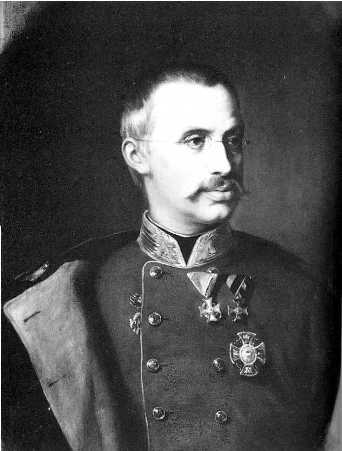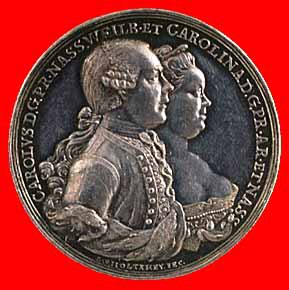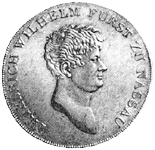|
Princess Henriette Alexandrine Of Nassau-Weilburg
Henrietta Alexandrine Friederike Wilhelmine of Nassau-Weilburg, then of Nassau (areas now part of Germany) (30 October 1797 Palace Eremitage, Bayreuth – 29 December 1829, Vienna) was the wife of Archduke Charles, Duke of Teschen. Her husband was a notable general of the Napoleonic Wars and victor of the Battle of Aspern-Essling against Napoleon I of France. Family Henrietta was the youngest daughter of Frederick William of Nassau-Weilburg (1768–1816) and his wife Burgravine Louise Isabelle of Kirchberg. Her maternal grandparents were Buggraf Georg Wilhelm von Kirchberg, Count of Sayn-Wittgenstein-Hachenburg (1751-1777) and his wife, Princess Isabelle Auguste Reuss of Greiz (1752-1824). Her paternal grandparents were Karl Christian of Nassau-Weilburg and Princess Wilhelmine Carolina of Orange-Nassau, both members of the different branches of an ancient House of Nassau. Wilhelmine Carolina was a daughter of William IV, Prince of Orange and his wife, Anne, Princess Royal. ... [...More Info...] [...Related Items...] OR: [Wikipedia] [Google] [Baidu] |
Duchess Of Teschen
Duchess of Teschen House of Piast, 1290–1653 House of Habsburg, 1653–1722 House of Lorraine, 1722–1765 House of Habsburg-Lorraine, 1765–1918 See also * List of Polish consorts * List of Austrian consorts * Holy Roman Empress * List of Hungarian consorts * List of Bohemian consorts * List of Lotharingian consorts * List of Tuscan consorts Notes References Sources {{DEFAULTSORT:Duchess Of Teschen Duchesses of Teschen, Lists of duchesses, Teschen ... [...More Info...] [...Related Items...] OR: [Wikipedia] [Google] [Baidu] |
Germany
Germany, officially the Federal Republic of Germany, is a country in Central Europe. It lies between the Baltic Sea and the North Sea to the north and the Alps to the south. Its sixteen States of Germany, constituent states have a total population of over 84 million in an area of , making it the most populous member state of the European Union. It borders Denmark to the north, Poland and the Czech Republic to the east, Austria and Switzerland to the south, and France, Luxembourg, Belgium, and the Netherlands to the west. The Capital of Germany, nation's capital and List of cities in Germany by population, most populous city is Berlin and its main financial centre is Frankfurt; the largest urban area is the Ruhr. Settlement in the territory of modern Germany began in the Lower Paleolithic, with various tribes inhabiting it from the Neolithic onward, chiefly the Celts. Various Germanic peoples, Germanic tribes have inhabited the northern parts of modern Germany since classical ... [...More Info...] [...Related Items...] OR: [Wikipedia] [Google] [Baidu] |
Anne, Princess Royal And Princess Of Orange
Anne, Princess Royal (12 January 1759) was the second child and eldest daughter of King George II of Great Britain and his consort Caroline of Ansbach. She was the wife of William IV, Prince of Orange, the first hereditary stadtholder of all seven provinces of the Northern Netherlands. She was Regent of the Netherlands from 1751 until her death in 1759, exercising extensive powers on behalf of her son William V, Prince of Orange, William V. She was known as an Anglophile, due to her English upbringing and family connections, but was unable to convince the Dutch Republic to enter the Seven Years' War on the side of the British. Princess Anne was the second daughter of a British sovereign to hold the title Princess Royal. In the Netherlands she was styled Anna van Hannover. Early life Anne was born at Herrenhausen Palace, Hanover, Germany, Hanover, five years before her paternal grandfather, Elector George Louis, succeeded to the thrones of Kingdom of Great Britain, Great Britai ... [...More Info...] [...Related Items...] OR: [Wikipedia] [Google] [Baidu] |
William IV, Prince Of Orange
William IV (Willem Karel Hendrik Friso; 1 September 1711 – 22 October 1751) was Prince of Orange from birth and the first hereditary stadtholder of all the United Provinces of the Netherlands from 1747 until his death in 1751. During his whole life, he was furthermore ruler of the Principality of Orange-Nassau within the Holy Roman Empire. Early life William was born in Leeuwarden, Netherlands, the posthumous son of John William Friso, Prince of Orange, head of the Frisian branch of the House of Orange-Nassau, and of his wife Landgravine Marie Louise of Hesse-Kassel (or Hesse-Cassel). He was born six weeks after the death of his father. William succeeded his father as Stadtholder of Friesland and also, under the regency of his mother until 1731, as Stadtholder of Groningen. In 1722 he was elected Stadtholder of Guelders. The four other provinces of the Dutch Republic—Holland, Zeeland, Utrecht and Overijssel—had in 1702 decided not to appoint a stadtholder after ... [...More Info...] [...Related Items...] OR: [Wikipedia] [Google] [Baidu] |
House Of Nassau
The House of Nassau is the name of a European aristocratic dynasty. The name originated with a lordship associated with Nassau Castle, which is located in what is now Nassau, Rhineland-Palatinate, Nassau in Rhineland-Palatinate, Germany. With the fall of the Hohenstaufen dynasty in the first half of the 13th century, royal power within Franconia evaporated and the former stem duchy fragmented into separate independent states. Nassau emerged as one of those independent states as part of the Holy Roman Empire. The lords of Nassau were originally titled "Counts of Nassau", subject only to the Holy Roman Emperor, Emperor, and then elevated to princely rank as "Princely Counts". Early on, the family divided into two main branches – the elder (Walramian) branch, which gave rise to the German king Adolf, King of the Romans, Adolf, and the younger (Ottonian) branch, which gave rise to the Prince of Orange, Princes of Orange and the King of the Netherlands, monarchs of the Netherlands. ... [...More Info...] [...Related Items...] OR: [Wikipedia] [Google] [Baidu] |
Princess Wilhelmine Carolina Of Orange-Nassau
Princess Carolina of Orange-Nassau (''Wilhelmine Carolina''; 16 February 1743 – 6 May 1787) was a Dutch regent. She was the daughter of William IV, Prince of Orange, Stadtholder of the Netherlands, and Anne, Princess Royal. She was regent of the Netherlands from 1765 until 1766 during the minority of her brother, William V. Life Princess Carolina was born in Leeuwarden, the eldest daughter of William IV, Prince of Orange, Stadtholder of the Netherlands, and Anne, Princess Royal. In 1747, it was declared that the position of stadtholder could be inherited by females, thus making the young Princess Carolina the heir presumptive to the position of stadtholder. However, in 1748, a male heir, William, was born to her parents, thus displacing her and putting her second in line to the position. She was given a good education in music. Princess Carolina's father died in 1751, making her three-year-old brother William V of Orange. At that point, her mother was appointed regent. Her marri ... [...More Info...] [...Related Items...] OR: [Wikipedia] [Google] [Baidu] |
Karl Christian Of Nassau-Weilburg
Charles Christian, Prince of Nassau-Weilburg (''Karl Christian'', 16 January 1735 in Weilburg – 28 November 1788 in Münster-Dreissen, near Kirchheim), till 1753 Count of Nassau-Weilburg, was the first ruler of the Principality of Nassau-Weilburg between 1753 and 1788. Family and rule He was the son of Charles August, Prince of Nassau-Weilburg and Princess Auguste Friederike of Nassau-Idstein. He succeeded his father in 1753 and united his territories in 1783 with Nassau-Saarbrücken, Nassau-Usingen and Nassau-Dietz. Marriage He married on 5 March 1760 in The Hague Princess Carolina of Orange-Nassau (1743–1787), daughter of William IV, Prince of Orange and Anne, Princess Royal. He became a general in the Dutch infantry, governor of Bergen op Zoom and governor of Maastricht (1773–1784). He negotiated in vain with the Patriots in 1787. He died in 1788 and was succeeded by his eldest surviving son Frederick William. Children He and Carolina had 15 children, some of who ... [...More Info...] [...Related Items...] OR: [Wikipedia] [Google] [Baidu] |
Principality Of Reuss-Greiz
The Principality of Reuss-Greiz (), officially called the Principality of the Reuss Elder Line () after 1848, was a state in the German Empire, ruled by members of the House of Reuss. The Counts Reuss of Greiz, Lower-Greiz and Upper-Greiz () were elevated to prince A prince is a male ruler (ranked below a king, grand prince, and grand duke) or a male member of a monarch's or former monarch's family. ''Prince'' is also a title of nobility (often highest), often hereditary, in some European states. The ...ly status in 1778 and thereafter bore the title of ''Prince Reuss, Elder Line'', or ''Prince Reuss of Greiz''. Similarly to the more numerous Principality of Reuss-Gera, Reuss Junior Line, the male members of this house were all named "Heinrich", in honour of Emperor Henry VI, Holy Roman Emperor, Heinrich VI, who had benefited the family. They were numbered sequentially by birth, rather than by reign, with the last series beginning with Heinrich I (born 1693) and ending ... [...More Info...] [...Related Items...] OR: [Wikipedia] [Google] [Baidu] |
Sayn-Wittgenstein-Hachenburg
Sayn-Wittgenstein-Hachenburg (sometimes called Sayn-Hachenburg) was a German County located in Rhineland-Palatinate, near the river Sieg. History When Count William III of Sayn-Wittgenstein-Sayn died in 1623 without clear heirs, the Archbishop of Cologne occupied the vacant County until the succession was settled. It was settled by treaty in 1648, when the county was given jointly to Countesses Ernestine and Johanetta, two sisters who were granddaughters of Count William, and their mother Dowager Countess Louise Juliane made regent. But shortly after the treaty, the county was split between the two. Ernestine's portion was called "Sayn-Wittgenstein-Hachenburg". Johanetta's was "Sayn-Wittgenstein-Sayn-Altenkirchen" (or Sayn-Altenkirchen for short). Their mother remained regent for both counties until 1652, when Johanetta and Ernestine separately ruled their respective Counties. Sayn-Wittgenstein-Hachenburg was inherited by Countess Magdalena Christina in 1661 following Ernesti ... [...More Info...] [...Related Items...] OR: [Wikipedia] [Google] [Baidu] |
Kirchberg An Der Iller
Kirchberg an der Iller (, ) is a municipality in Baden-Württemberg in the south-west of Germany and in the very east of the "Landkreis Biberach". Biberach is the capital of the district. Kirchberg is located in Swabia near the small river Iller, which forms part the border between Baden-Württemberg and Bavaria Bavaria, officially the Free State of Bavaria, is a States of Germany, state in the southeast of Germany. With an area of , it is the list of German states by area, largest German state by land area, comprising approximately 1/5 of the total l .... Kirchberg was first mentioned in 806 in the Codex of the St. Gallen Closters. There are two even smaller villages called Sinningen and Nordhofen which belong to Kirchberg. All together there live about 1,900 people. In Sinningen there is a camping ground near a small lake which is called Baggersee. The biggest employer in Kirchberg is Karl Miller GmbH. Here work about 200 people producing metal housing. There are als ... [...More Info...] [...Related Items...] OR: [Wikipedia] [Google] [Baidu] |
Burgrave
Burgrave, also rendered as burggrave (from , ), was since the medieval period in Europe (mainly Germany) the official title for the ruler of a castle, especially a royal or episcopal castle, and its territory called a ''Burgraviate'' or ''Burgravate'' (German ''Burggrafschaft'' also ''Burggrafthum'', Latin ''praefectura'').Encyclopædia Britannica; Definition of ''burgrave (title)''/ref> Duden; Definition of ''Burggraf'' (in German)/ref> The burgrave was a "count" in rank (German ''Graf'', Latin ''comes'') equipped with judicial powers, under the direct authority of the emperor or king, or of a territorial imperial state—a prince-bishop or territorial lord. The responsibilities were administrative, military and jurisdictional. In time the position came to be a purely administrative position held by middle or high ranking civil servants. A burgrave, who ruled over a substantially large territory, might also have possessed the regality of coinage, and could mint his own regi ... [...More Info...] [...Related Items...] OR: [Wikipedia] [Google] [Baidu] |
Frederick William Of Nassau-Weilburg
Frederick William, Prince of Nassau-Weilburg (''Friedrich Wilhelm'', 25 October 1768, The Hague – 9 January 1816, Weilburg) was a ruler of Nassau-Weilburg. He was created Prince of Nassau and reigned jointly with his cousin, Prince Frederick Augustus of Nassau-Usingen, who became Duke of Nassau. Frederick William died in January 1816, only two months before his cousin. Both men were succeeded by Frederick William's son, William. Family Frederick William was the eldest surviving son of Karl Christian of Nassau-Weilburg and Princess Wilhelmine Carolina of Orange-Nassau. Wilhelmine Carolina was a daughter of William IV, Prince of Orange and Anne, Princess Royal and Princess of Orange. Anne was in turn the eldest daughter of George II of Great Britain and Caroline of Ansbach. Marriage and children On 31 July 1788 in Hachenburg, Frederick William married Burgravine Louise Isabelle of Kirchberg ( Hachenburg, 19 April 1772 – Vienna, 6 January 1827). The groom was almost twenty ... [...More Info...] [...Related Items...] OR: [Wikipedia] [Google] [Baidu] |









